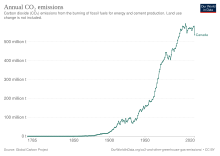This article has multiple issues. Please help improve it or discuss these issues on the talk page. (Learn how and when to remove these messages)
|
Canada total primary energy consumption by fuel in 2015[1]

| Part of a series on the |
| Economy of Canada |
|---|
 |
Canada has access to all main sources of energy including oil and gas, coal, hydropower, biomass, solar, geothermal, wind, marine and nuclear. It is the world's second largest producer of uranium,[2] third largest producer of hydro-electricity,[3] fourth largest natural gas producer, and the fifth largest producer of crude oil.[4] In 2006, only Russia, the People's Republic of China, the United States and Saudi Arabia produce more total energy than Canada.[5]
The United States is Canada's major trade market for energy products and services. Canada sent around 98% of its total energy exports to the United States in 2015, meaning that Canada is the largest supplier of energy exports to the world's largest economy. Canada also exports significant amounts of uranium and coal to Asia, Europe and Latin America.[6]
Despite being a net energy exporter, Canada also imports energy products. $24.5 billion of energy products were imported in 2004.[5]
Canada has a robust energy profile with abundant and diverse resources. The energy and climate policies in Canada are interrelated. These energy and climate policies are implemented at both the federal and provincial government level. The federal government is responsible for establishing objectives for the entire country and the provincial governments are responsible for enforcing these objectives and developing the methods to achieve these goals.[7] In 2015, the federal and provincial governments created a national agreement for cooperating in boosting the nation's energy industry while transitioning to a low-carbon economy.[8] Provincial governments are developing their own strategies in order to reach the national goals. In 2016, Prince Edward Island Strategy became one of the first provinces to develop their own strategies in response to the federal agreement goals.[9]
In 2015, Canada paid US$43 billion in post-tax energy subsidies according to a 2019 International Monetary Fund (IMF) report.[10]: 35
- ^ "Statistical Review of World Energy (June 2016)" (PDF). bp.com. Retrieved 8 April 2018.
- ^ "World Nuclear Mining Production". World Nuclear Mining. 19 May 2016. Retrieved 19 June 2016.
- ^ "Canadian Hydropower By the Numbers". Canadian Hydropower Association. Archived from the original on 3 November 2017. Retrieved 19 June 2016.
- ^ "Energy Fact Book 2015-2016" (PDF). Natural Resources Canada. 2015. Retrieved 19 June 2016.
- ^ a b "Canadian Energy Facts". Foreign Affairs and International Trade Canada. December 2006. Archived from the original on 20 May 2011. Retrieved 16 August 2008.
- ^ Canada Energy Policy Laws and Regulation Handbook. Washington DC: International Business Publication, USA. 2015. p. 39. ISBN 9781312950481.
- ^ Fertel, Camille (2013). "Canadian energy and climate policies: A SWOT analysis in search of federal/provincial coherence". Energy Policy. 63: 1139–1150. doi:10.1016/j.enpol.2013.09.057.
- ^ Laverty, Gene (20 July 2015). "Canada's Provincial leaders reach agreement on energy strategy". SNL Energy Power Daily: 1–3.
- ^ Prince Edward Island Provincial Energy Strategy 2016/17 (PDF) (Report).
- ^ Cite error: The named reference
IMF_Coady_20190502was invoked but never defined (see the help page).